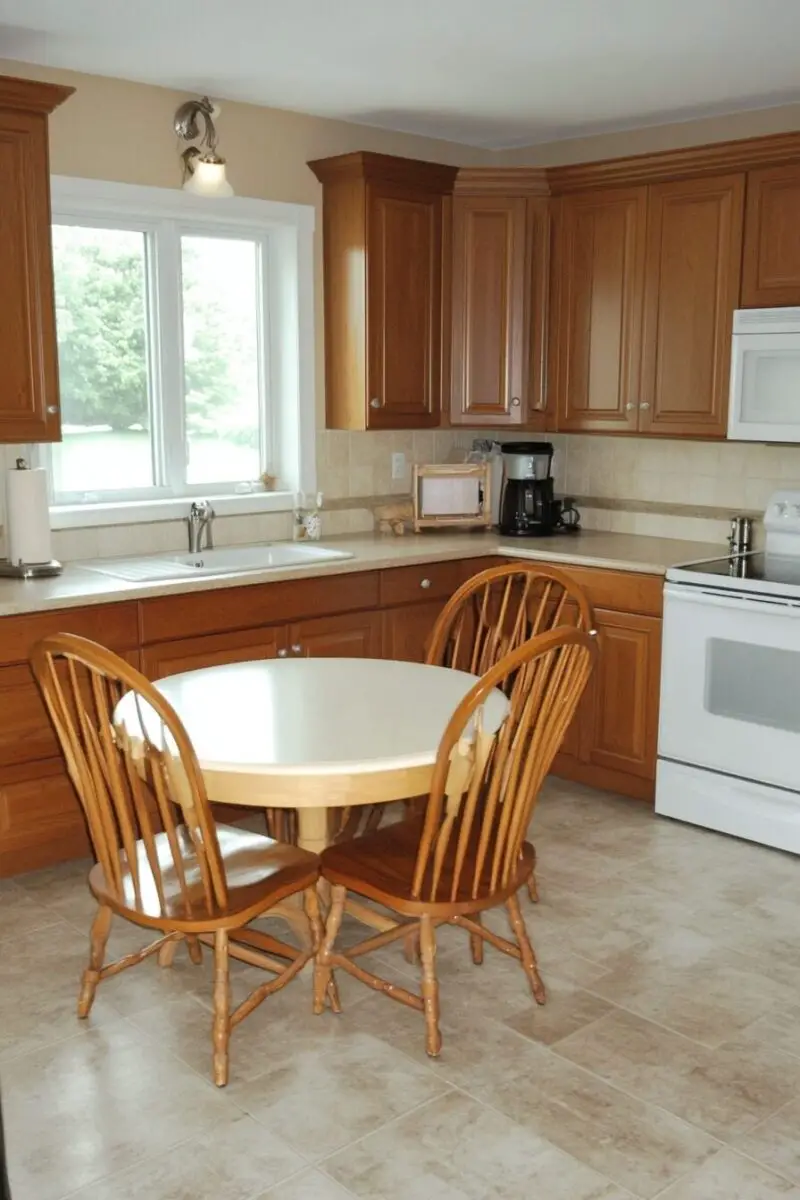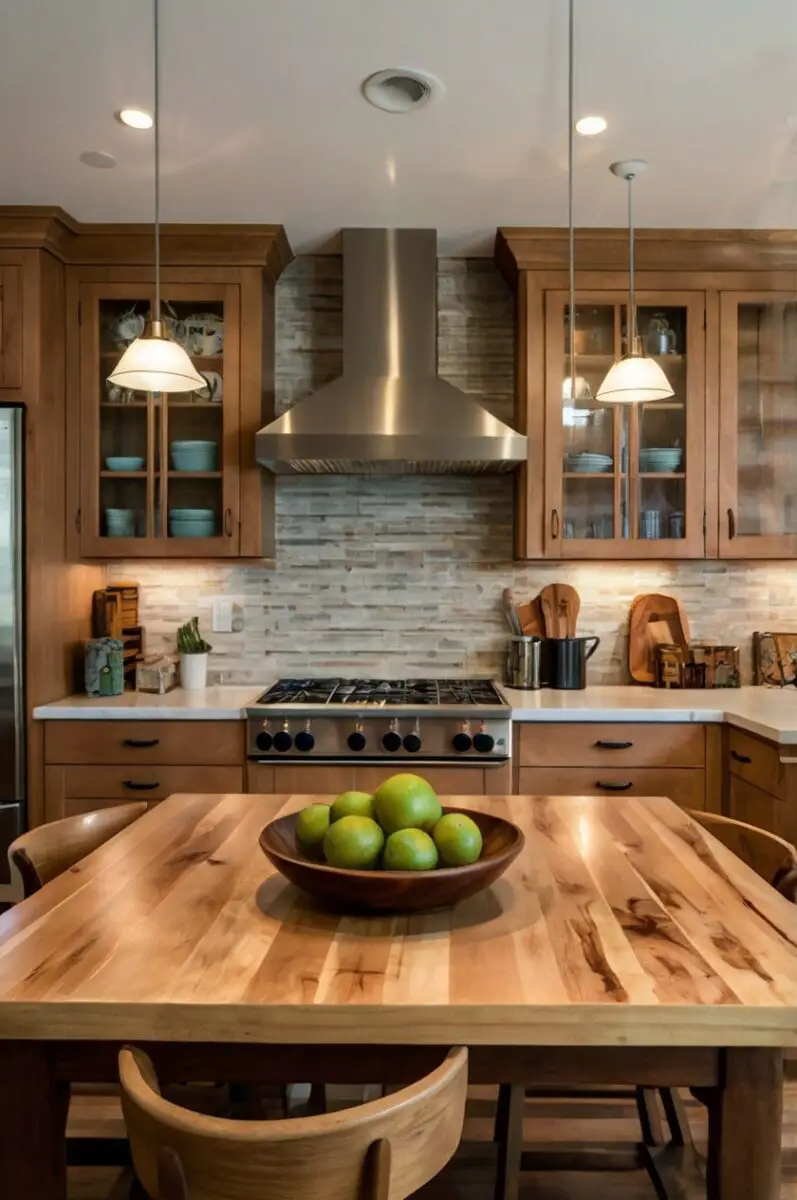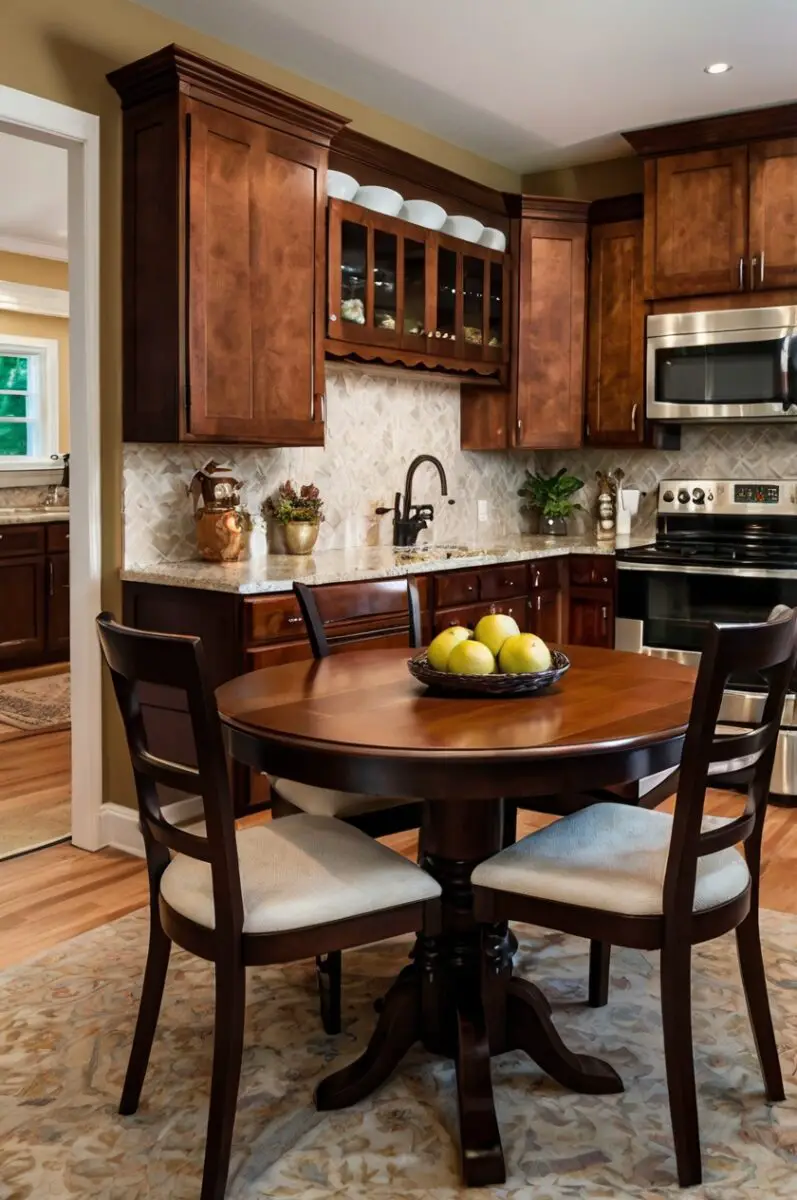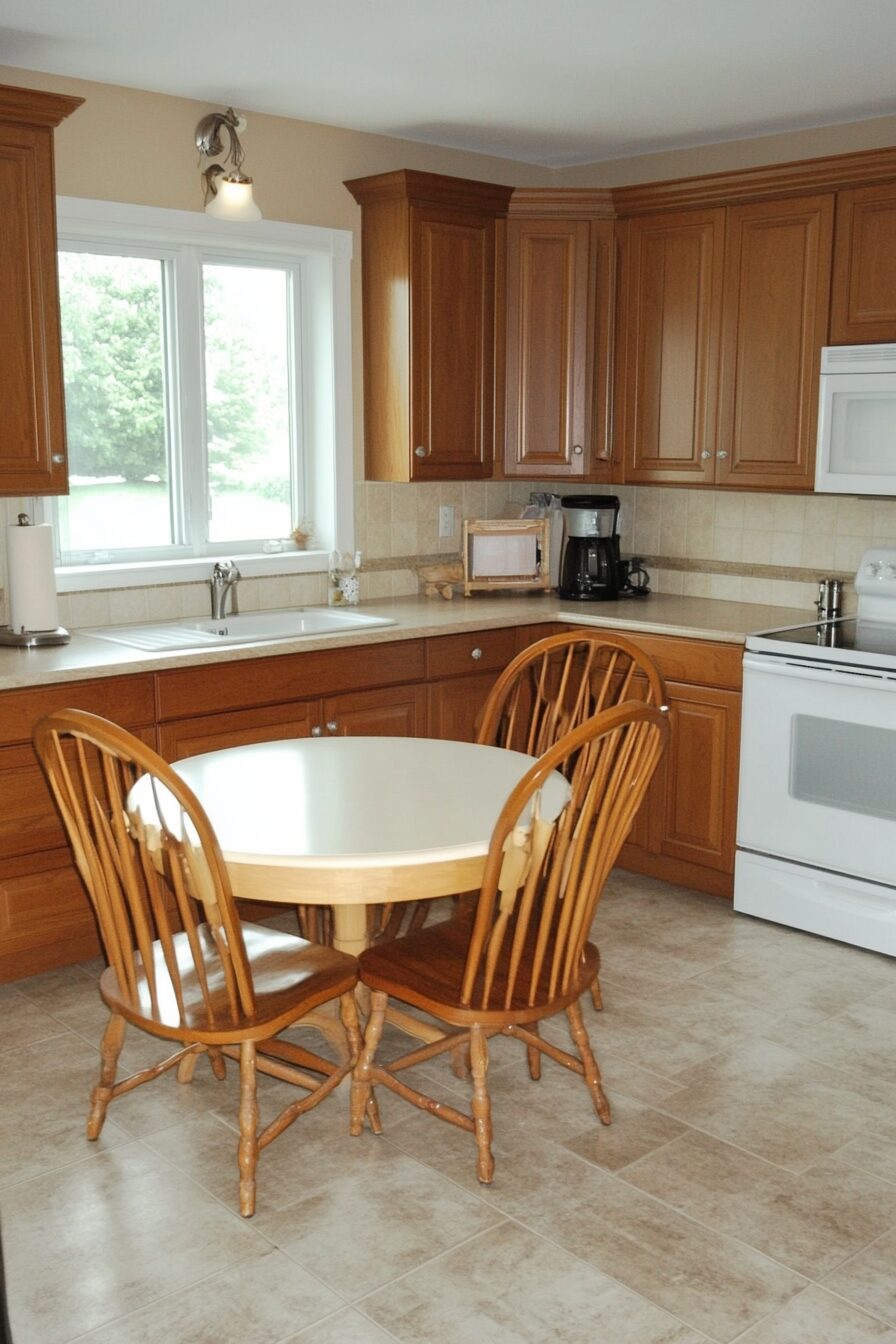I’ve been helping friends style their kitchens for years, and matching tables with maple cabinets is one of my favorite challenges.
Maple brings such a warm, inviting energy to a space—I had maple cabinets in my first home and spent weeks finding the perfect table to complement them!
With maple cabinets as your foundation, you’ve got so many exciting directions to take your design.
My suggestions come from my personal experience, conversations with interior designers, and countless hours scrolling through home makeovers on Pinterest:
1. Classic White for Clean Contrast


White tables create a stunning contrast against maple cabinets that instantly brightens your entire kitchen.
The crisp, clean look of a white table helps balance the warm honey tones in your maple cabinetry.
This pairing works especially well in kitchens with limited natural light, as the white reflects what light you do have, making the space feel larger and more open.
When I helped my sister choose a table for her maple kitchen, she went with a white farmhouse-style table that completely transformed the space from dark and dated to fresh and inviting.
White tables come in many styles—from modern glossy finishes to distressed cottage looks—giving you flexibility to match your overall kitchen aesthetic.
For a cohesive look, try adding white accents elsewhere in the kitchen, like white countertops, backsplash tiles, or decorative items.
The beauty of white is its timelessness—it won’t go out of style while other trends come and go.
If you’re worried about keeping a white table clean (especially with kids or frequent entertaining), look for durable finishes or consider a white quartz tabletop that resists stains.
Many homeowners find that white tables make their maple cabinets appear richer and more luxurious by comparison.
The stark contrast between maple and white creates visual interest that draws the eye and makes your kitchen more dynamic.
For small kitchens, a white table helps maintain an airy, spacious feel rather than adding visual heaviness.
White tables also provide a neutral backdrop for colorful dishware, placemats, or centerpieces that you can change seasonally.
This pairing works with both light and dark maple finishes, though the contrast will be more dramatic with darker maple cabinets.
2. Natural Wood Tones for Harmonious Flow


Choosing a table that matches your maple cabinets creates a seamless, cohesive look throughout your kitchen.
This approach feels organic and grounded, especially in homes with natural themes or farmhouse styles.
When I renovated my own kitchen, I chose a table with a similar finish to my maple cabinets, and guests always comment on how pulled-together the space feels.
The key is finding a wood tone that’s close but not an exact match—a slight variation prevents the space from feeling flat or one-dimensional.
Look for tables made from maple, oak, or birch with similar golden or honey undertones to your cabinets.
This matching approach makes your kitchen feel larger because the eye flows smoothly from cabinets to table without interruption.
Natural wood tables add warmth and texture that makes your kitchen feel more inviting and lived-in.
For added interest, consider a table with a slightly different finish—perhaps your cabinets are glossy while your table has a matte or hand-rubbed oil finish.
Wood-on-wood combinations work particularly well in traditional, rustic, or craftsman-style homes where natural materials are celebrated.
If your maple cabinets have distinctive grain patterns, a simpler grain pattern on your table can provide balance without competition.
Natural wood tables age beautifully, developing character that complements the patina your maple cabinets will develop over time.
For smaller kitchens, this tone-on-tone approach creates visual continuity that doesn’t break up the space with stark contrasts.
Consider adding fabric chair cushions in a complementary color to prevent the space from feeling too monotone.
Design Your Dream Room in Minutes!
🏡 Start Creating FREE →3. Deep Cherry for Sophisticated Warmth

Cherry wood tables pair beautifully with maple cabinets, creating a rich, layered look that exudes traditional elegance.
The deep reddish-brown tones of cherry provide enough contrast to stand out while still complementing the warm undertones in maple.
I once helped design a kitchen where we paired medium maple cabinets with a dark cherry table, and the combination looked like it came straight from a luxury home magazine.
This pairing works especially well in kitchens with traditional architectural details like crown molding or raised panel cabinet doors.
Cherry wood naturally darkens over time, developing a gorgeous patina that adds character to your kitchen.
For a cohesive look, consider cherry wood chairs or stools that match your table, creating a distinctive dining area within your maple kitchen.
The contrast between lighter maple and deeper cherry creates visual interest that draws people into the space.
In larger kitchens, a substantial cherry table can serve as a stunning focal point that anchors the room.
Many designers recommend this combination for homes with classic or colonial-inspired décor schemes.
Cherry’s rich color helps hide minor scratches and wear, making it practical for busy families while still looking sophisticated.
This pairing works particularly well with pendant lighting that casts a warm glow, enhancing the natural beauty of both wood types.
If you have stainless steel appliances, the warmth of cherry wood helps balance their cool tones.
For an extra touch of luxury, look for cherry tables with decorative details like turned legs or scrollwork.
4. Black for Bold, Modern Contrast
A black kitchen table creates dramatic contrast against maple cabinets, instantly modernizing your entire kitchen.
This high-contrast pairing makes a strong design statement that feels intentional and contemporary.
When my neighbor installed a matte black table with her light maple cabinets, it transformed her traditional kitchen into a magazine-worthy modern space overnight.
Black tables work particularly well with lighter maple finishes, as the contrast highlights the natural beauty of both elements.
This color combination creates a perfect backdrop for adding colorful accessories that can be changed seasonally.
In open concept homes, a black table helps define the dining area as a distinct zone while still coordinating with the maple kitchen.
Black tables come in various materials—from painted wood to metal to stone—giving you flexibility to match your overall style.
The sleek look of black pairs beautifully with stainless steel appliances, creating a cohesive modern aesthetic.
For smaller kitchens, consider a black table with a glass top or slim profile to maintain the bold look without overwhelming the space.
Black is incredibly practical for busy households, as it hides crumbs and small spills between cleanings.
This combination works in various design styles, from industrial to farmhouse modern to minimalist contemporary.
If a completely black table feels too dominant, consider a two-tone option with black legs and a wood top that picks up the maple tones.
Adding black accents elsewhere in the kitchen—like hardware, lighting fixtures, or bar stools—creates a cohesive look that ties everything together.
5. Gray for Contemporary Elegance
Gray tables bring a sophisticated neutrality that complements maple cabinets without competing with their warm tones.
This combination feels current and fresh while still being timeless enough to outlast passing trends.
I recently helped a client select a weathered gray farmhouse table for her maple kitchen, and the result was this beautiful balance of warmth and coolness.
Gray comes in countless shades—from light dove to deep charcoal—allowing you to adjust the level of contrast with your particular maple cabinets.
For kitchens with stainless steel appliances, a gray table creates a cohesive color story that feels intentional and designed.
This pairing works particularly well with contemporary or transitional kitchen styles that blend traditional and modern elements.
Gray tables can be found in various materials, including painted wood, concrete, or metal, each bringing a different texture to your kitchen.
The neutral nature of gray makes it an excellent foundation for seasonal decorating, allowing you to add colorful runners, centerpieces, or dinnerware.
In kitchens with limited natural light, lighter gray tones help keep the space feeling bright and airy.
If your maple cabinets have strong yellow undertones, a gray table with slight blue undertones can help balance the warmth.
For a cohesive look, consider adding gray elements elsewhere, like bar stools, pendant lights, or a backsplash.
Gray tables show less dust and everyday wear than darker options, making them practical for busy households.
This combination creates a sophisticated backdrop for both casual family meals and elegant dinner parties.
TRENDING NOW
15 Ways To Bring Bohemian Vibes Into Your Kitchen6. Glass-Top Tables for Airy Elegance
Glass tables create a light, airy feeling that lets your maple cabinets remain the star of the show.
The transparent nature of glass helps make smaller kitchens feel more spacious and less crowded.
When I renovated my sister’s compact kitchen with maple cabinets, a round glass-top table completely transformed the space from cramped to open and elegant.
Glass tables reflect light beautifully, brightening your entire kitchen and making the warm tones in your maple cabinets appear even richer.
These tables come with various base styles—from brushed nickel to wrought iron to wood—letting you introduce complementary materials to your kitchen.
For a cohesive look, consider a table with a base color that matches your kitchen hardware or lighting fixtures.
Glass-top tables are incredibly versatile and work with nearly any design style, from ultra-modern to traditional.
The neutral quality of glass means you’ll never have to worry about clashing with your maple cabinets if you change other elements of your kitchen down the road.
These tables create a visual lightness that balances the substantial appearance of wood cabinetry.
For families with young children, look for tempered glass options that are more resistant to chips and cracks.
Glass tables are surprisingly easy to clean—a simple glass cleaner keeps them looking sparkling and new.
If you entertain frequently, glass-top tables create an elegant foundation for beautiful table settings that will impress your guests.
For a unique look, consider glass tables with interesting textures, frosted patterns, or subtle tints that complement your maple cabinets.
TRENDING NOW
13 Stylish Industrial Kitchen Makeovers7. Navy Blue for Unexpected Sophistication
Navy blue tables create a rich, unexpected contrast with maple cabinets that feels both classic and current.
This bold pairing works because navy acts as a sophisticated neutral that enhances the warm golden tones in maple.
I recently transformed a client’s kitchen with a navy blue farmhouse table that completely elevated her maple cabinets from basic to designer-inspired.
Navy brings depth and character to your kitchen without the starkness of black or the commonness of brown.
This color combination works particularly well in coastal, preppy, or traditional home styles.
Navy tables create a perfect backdrop for lighter colored dishes, making your table settings pop dramatically.
For a cohesive look, consider adding small navy blue accents elsewhere in the kitchen, like dish towels, a runner, or decorative ceramics.
This pairing feels especially fresh in kitchens with white countertops and backsplashes, creating a classic color story.
Navy blue hides everyday wear and spills better than lighter colors, making it practical for busy households.
If a fully navy table feels too bold, consider a two-tone option with navy legs and a natural wood top that picks up the maple tones.
This combination creates an anchor point in open concept homes, defining your dining area while still coordinating with the kitchen.
The contrast between warm maple and cool navy creates a balanced, designer-inspired look that appeals to many different tastes.
Navy is timeless enough to outlast passing trends while still feeling current and fresh.
8. Butcher Block for Rustic Charm
Butcher block tables bring natural warmth that complements maple cabinets beautifully, creating a cohesive, organic kitchen.
The varied tones within butcher block enhance the natural variations in your maple cabinets, creating depth and visual interest.
When I added a butcher block table to my own maple kitchen, it immediately made the space feel more inviting and gathered.
This combination works particularly well in farmhouse, rustic, or cottage-style kitchens where natural materials are celebrated.
Butcher block tables age gracefully, developing character over time that only enhances your kitchen’s lived-in charm.
The natural wood grain provides subtle pattern and texture that enlivens your kitchen without overwhelming it.
These tables are incredibly durable and practical—minor scratches can be sanded away, making them perfect for busy families.
For a cohesive look, consider butcher block that incorporates some of the same tones found in your maple cabinets.
Many homeowners find that this natural wood-on-wood combination creates a warm, inviting atmosphere that guests comment on.
Butcher block tables come in various wood types—maple, oak, walnut, or mixed woods—giving you flexibility to find the perfect match.
This pairing creates a timeless look that won’t feel dated as trends come and go.
For visual interest, consider a butcher block table with a different edge profile or thickness than your countertops.
The natural variations in butcher block help hide crumbs and small spills between cleanings, making it practical for everyday use.
9. Distressed White for Farmhouse Chic
Distressed white tables pair beautifully with maple cabinets, creating that popular farmhouse look that feels both fresh and timeless.
The aged, imperfect finish adds character and story to your kitchen, balancing the more uniform appearance of cabinet fronts.
I helped my cousin choose a distressed white pedestal table for her maple kitchen, and it instantly transformed the space from basic to magazine-worthy.
This combination works particularly well if you’re going for a country, cottage, or modern farmhouse aesthetic.
The textured white finish provides contrast without the starkness of bright white, making it feel more relaxed and lived-in.
Distressed tables typically show wear and tear gracefully, making them practical choices for busy households with children.
The warm undertones often visible in distressed finishes complement the honeyed warmth of maple cabinets.
For a cohesive look, consider adding other distressed white elements like a hutch, bar stools, or decorative accessories.
This pairing creates a perfect backdrop for colorful dishes, fresh flowers, or seasonal décor that you can change throughout the year.
Many homeowners find that this combination makes their kitchen feel more relaxed and welcoming—perfect for lingering family meals.
Distressed white tables come in many styles—from chunky farmhouse designs to more delicate French country looks—giving you flexibility to match your overall aesthetic.
This finish hides everyday crumbs and smudges better than solid white, making it practical for frequent use.
The contrast between structured maple cabinets and a weathered table creates visual interest that draws people into your kitchen.
10. Teal or Turquoise for Vibrant Energy
Teal or turquoise tables create a stunning color pop against maple cabinets that instantly energizes your entire kitchen.
This unexpected color combination works because the cool blue-green tones complement the warm amber undertones in maple.
When I helped my best friend choose a teal table for her maple kitchen, visitors immediately started asking who her designer was!
This pairing creates a memorable, personality-filled kitchen that reflects confidence and creativity.
Teal ranges from deeper jewel tones to brighter aqua shades, giving you flexibility to find the perfect intensity for your space.
In kitchens that feel too traditional or plain, a turquoise table instantly adds contemporary flair without a complete renovation.
This combination works particularly well in cottage, coastal, or eclectic-style homes where color is celebrated.
For a cohesive look, carry small touches of your table color elsewhere—through dishware, art, or even cabinet hardware.
Colorful tables create an instant focal point, drawing the eye and defining your dining area in open-concept spaces.
The contrast between natural wood and bold color creates visual interest that makes your kitchen feel professionally designed.
If a fully teal table feels too bold, consider a two-tone option with colored legs and a natural wood top that ties back to your cabinets.
This pairing feels especially fresh when combined with white countertops or backsplashes that help the colors pop.
Teal and turquoise hide everyday crumbs and small spills better than lighter colors, making them surprisingly practical choices.
11. Marble-Top for Luxurious Contrast
Marble-top tables bring an instant touch of luxury that elevates maple cabinets to designer status.
The cool white and gray tones of marble create beautiful contrast against the warm honey colors in maple.
I recently helped a client pair a round marble-top table with her maple kitchen, and the combination made the space feel like a high-end custom design.
This pairing works in many styles—from traditional to modern to transitional—making it incredibly versatile.
Marble’s natural veining adds subtle pattern and movement that enlivens your kitchen without overwhelming it.
For kitchens with stone countertops, a marble table creates material continuity while still defining the dining area as its own space.
The substantial look of marble balances the visual weight of wood cabinetry, creating a harmonious overall design.
White marble especially helps brighten kitchens with limited natural light, reflecting what light you do have.
This combination creates a perfect backdrop for both casual family breakfasts and elegant dinner parties.
If natural marble feels too high-maintenance, consider marble-look quartz or porcelain options that offer similar beauty with greater durability.
For a cohesive look, choose a table base color that coordinates with your cabinet hardware or lighting fixtures.
The timeless quality of both maple and marble ensures your kitchen won’t look dated as trends come and go.
This luxurious pairing creates a sophisticated foundation that elevates everything else in your kitchen.
TRENDING NOW
13 Elegant Kitchens Featuring Hickory Cabinets12. Walnut for Rich Contrast
Walnut tables create a rich, sophisticated contrast with maple cabinets that feels both intentional and harmonious.
The deep chocolate tones of walnut provide striking contrast while still feeling natural alongside maple’s honey hues.
When I helped design my neighbor’s dining area, we chose a substantial walnut table that instantly made her maple kitchen feel more upscale and curated.
This wood combination works because both are natural materials with warm undertones, creating contrast without clash.
For traditional or craftsman-style homes, this pairing honors the tradition of mixing complementary wood tones.
Walnut’s distinctive grain patterns add visual interest that balances the more uniform appearance of most maple cabinets.
This combination creates a rich, layered look that suggests your furniture was thoughtfully collected rather than purchased as a matching set.
For a cohesive look, consider walnut accents elsewhere in your kitchen, like a knife block, serving bowls, or decorative items.
The contrast between lighter maple and deeper walnut draws the eye and defines your dining area in open-concept spaces.
Walnut ages beautifully, developing a rich patina over time that enhances your kitchen’s lived-in charm.
This pairing creates a timeless look that transcends passing trends, ensuring your kitchen won’t feel dated five years from now.
For families with children, walnut’s darker tone hides everyday wear and small spills better than lighter woods.
If you have stainless steel appliances, walnut’s warmth helps balance their cool tones, creating harmony throughout your kitchen.
13. Two-Tone Tables for Perfect Balance
Two-tone tables offer the best of both worlds, allowing you to incorporate colors that both contrast with and complement your maple cabinets.
These versatile pieces typically feature different colors or materials for the top and base, creating built-in coordination with your kitchen elements.
I recently helped a family choose a table with a weathered wood top and black metal legs that perfectly bridged their maple cabinets and black appliances.
This approach allows you to acknowledge your maple cabinets while still introducing new colors or materials that reflect your personal style.
Two-tone tables feel current and thoughtfully designed, adding a custom look to your kitchen.
For instance, a table with a maple top and white legs creates continuity with your cabinets while adding freshness.
These tables work in nearly any design style, from industrial to farmhouse to contemporary.
The dual-material approach adds visual interest and helps define your dining area as its own distinct space.
Two-tone options allow you to incorporate trending colors in a more subtle way that won’t feel dated quickly.
For open-concept homes, these tables help bridge your kitchen with adjacent living areas, creating cohesion throughout your space.
Many homeowners find that two-tone tables make decorating easier, as they already incorporate multiple colors to coordinate with.
This approach often looks more collected and personal than single-color options that can feel mass-produced.


